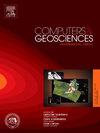利用真实的三维几何图形模拟石榴石中主要元素的扩散
IF 4.4
2区 地球科学
Q1 COMPUTER SCIENCE, INTERDISCIPLINARY APPLICATIONS
引用次数: 0
摘要
石榴石中主要元素的化学扩散是角闪岩-麻粒岩相变质岩中普遍存在的现象。对这一过程的研究导致了对变质作用速率和时间尺度的重要限制,例如使用地质测速法和正演热力学模型。然而,到目前为止,大多数模型在模拟石榴石中的扩散时都假设了球坐标和简单的几何形状。在这项研究中,我们提出了一个运行三维多组分扩散模型的框架,该模型是由微观计算机断层扫描获得的真实晶粒几何形状。我们介绍一个开源代码,DiffusionGarnet。jl,用Julia编程语言编写的高性能。我们证明了数值求解器的高效率,稳定的显式方法,以及使用GPU加速的可扩展性。该方法应用于两种具有不同特征的石榴石晶粒,一种是自面体的井形晶粒,另一种是变形的亚自面体晶粒,从岩心到边缘与基体的连通性较高。从相似的初始成分出发,在700°C和0.8 GPa / 10 Myr的恒定条件下,模型显示出非常不同的特征。自面形晶粒的结果与球形假设的预测结果相似,在很大程度上保留了其原有的分带。相比之下,亚自面体晶粒表现出明显的再平衡,几乎完全消除了其最初的分带。这种行为是由与矩阵的高连通性引起的。除了为三维扩散建模提供鲁棒解算器外,这些结果还证明了晶粒几何形状和矩阵连通性对晶粒内扩散的作用,并突出了3D方法在正确研究天然晶粒复杂性方面的作用。本文章由计算机程序翻译,如有差异,请以英文原文为准。
Simulating major element diffusion in garnet using realistic 3D geometries
Chemical diffusion of major elements in garnet is a common phenomenon in amphibolite to granulite facies metamorphic rocks. The study of this process has led to important constraints on the rate and timescale of metamorphism, for instance using geospeedometry and forward thermodynamic modelling. However, to date, most models have assumed spherical coordinates and simple geometries when modelling diffusion in garnet. In this study, we present a framework for running 3D multicomponent diffusion models from real grain geometries obtained by micro-computed tomography. We introduce an open-source code, DiffusionGarnet.jl, written for high performance in the Julia programming language. We demonstrate the high efficiency of the numerical solver, a stabilised explicit method, and its scalability using GPU acceleration. This approach is applied to two garnet grains with different characteristics, a euhedral well-shaped grain and a deformed sub-euhedral grain with a high connectivity to the matrix from core to rim. Starting from a similar initial composition and at constant conditions of 700 °C and 0.8 GPa for 10 Myr, the models show results with very different characteristics. The euhedral grain shows results similar to those predicted with a spherical assumption, largely preserving its original zoning. In contrast, the sub-euhedral grain shows significant re-equilibration, nearly erasing completely its initial zoning. This behaviour is caused by the high connectivity with the matrix. In addition to providing a robust solver for 3D diffusion modelling, these results demonstrate the role of grain geometry and matrix connectivity on intra-grain diffusion and highlight the power of 3D approaches to properly study the complexity of natural grains.
求助全文
通过发布文献求助,成功后即可免费获取论文全文。
去求助
来源期刊

Computers & Geosciences
地学-地球科学综合
CiteScore
9.30
自引率
6.80%
发文量
164
审稿时长
3.4 months
期刊介绍:
Computers & Geosciences publishes high impact, original research at the interface between Computer Sciences and Geosciences. Publications should apply modern computer science paradigms, whether computational or informatics-based, to address problems in the geosciences.
 求助内容:
求助内容: 应助结果提醒方式:
应助结果提醒方式:


